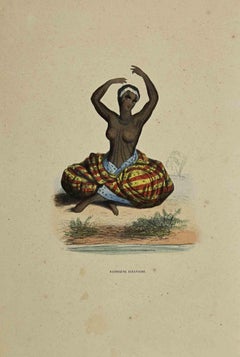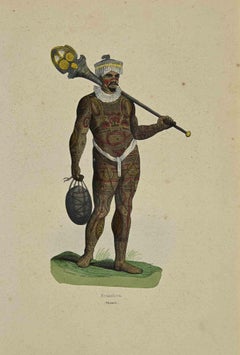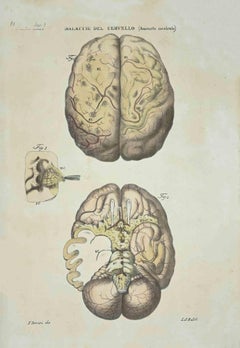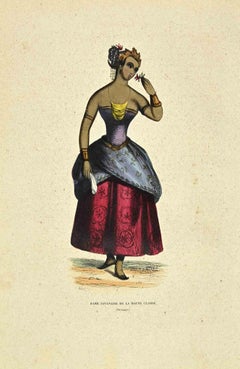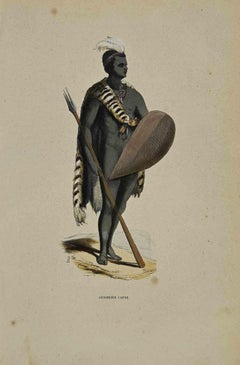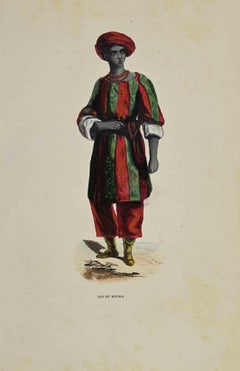1840s Art
to
35
607
293
45
18
14
Overall Width
to
Overall Height
to
7,476
21,066
160,116
233,353
1,940
2,227
4,770
6,398
5,824
14,946
20,284
25,512
17,786
13,653
5,305
702
13
7
1
1
621
347
4
641
290
242
194
132
127
101
93
84
62
61
48
43
40
31
31
27
27
24
24
670
128
114
78
63
40
38
27
15
8
123
707
744
145
Period: 1840s
Danseuse Javanaise - Lithograph by Auguste Wahlen - 1844
Located in Roma, IT
Danseuse Javanaise is a hand colored lithographs realized by Auguste Wahlen in 1844.
Good condition.
The artwork belongs to the Suite Moeurs, usages et costumes de tous les peuples...
Category
Modern 1840s Art
Materials
Lithograph
Noukahiwa - Lithograph by Auguste Wahlen - 1844
Located in Roma, IT
Noukahiwa is a hand colored lithographs realized by Auguste Wahlen in 1844.
Good conditions.
The artwork belongsto the Suite Moeurs, usages et costume...
Category
Modern 1840s Art
Materials
Lithograph
Brain Diseases - Lithograph By Ottavio Muzzi - 1843
Located in Roma, IT
Brain Diseases is a lithograph hand colored by Ottavio Muzzi for the edition of Antoine Chazal, Human Anatomy, Printers Batelli and Ridolfi, 1843.
The work belongs to the Atlante ge...
Category
Modern 1840s Art
Materials
Lithograph
Dame Javanaise de la Haute Classe - Lithograph by Auguste Wahlen - 1844
Located in Roma, IT
Dame Javanaise de la Haute Classe is a hand colored lithographs realized by Auguste Wahlen in 1844.
Good condition.
The artwork belongs to the Suite Moeurs, usages et costumes de t...
Category
Modern 1840s Art
Materials
Lithograph
Guerrier Cafre - Lithograph by Auguste Wahlen - 1844
Located in Roma, IT
Guerrier Cafre is a hand colored lithograph realized by Auguste Wahlen in 1844.
Good conditions.
The artwork belongs to the Suite Moeurs, usages et costumes de tous les peuples du ...
Category
Modern 1840s Art
Materials
Lithograph
Roi de Boussa - Lithograph by Auguste Wahlen - 1844
Located in Roma, IT
Roi de Boussa is a hand colored lithographs realized by Auguste Wahlen in 1844.
Good conditions.
The artwork belongs to the Suite Moeurs, usages et costumes de tous les peuples du ...
Category
Modern 1840s Art
Materials
Lithograph
Chef d'une Tribu de la Nouvelle Zelande - Lithograph by Auguste Wahlen - 1844
Located in Roma, IT
Chef d'une Tribu de la Nouvelle Zelande is a hand colored lithograph realized by Auguste Wahlen in 1844.
good conditions.
the artwork belongsto the Suite Moeurs, usages et costumes...
Category
Modern 1840s Art
Materials
Lithograph
Guerrier de Souraki - Lithograph by Auguste Wahlen - 1844
Located in Roma, IT
Guerrier de Souraki is a hand colored lithograph realized by Auguste Wahlen in 1844.
Good conditions.
The artwork belongsto the Suite Moeurs, usages et costumes de tous les peuples...
Category
Modern 1840s Art
Materials
Lithograph
Small Intestine Diseases - Lithograph By Ottavio Muzzi - 1843
Located in Roma, IT
Small Intestine Diseases is a lithograph hand colored by Ottavio Muzzi, for the edition of Antoine Chazal, Human Anatomy, Printers Batelli and Ridolfi, realized in 1843.The artwork b...
Category
Modern 1840s Art
Materials
Lithograph
Jeune Dame Mulatre - Lithograph by Auguste Wahlen - 1844
Located in Roma, IT
Jeune Dame Mulatre is a hand colored lithographs realized by Auguste Wahlen in 1844.
Good conditions.
The artwork belongs to the Suite Moeurs, usages et costumes de tous les peuple...
Category
Modern 1840s Art
Materials
Lithograph
Conformation Defects - Lithograph By Ottavio Muzzi - 1843
Located in Roma, IT
Conformation Defects is a lithograph hand colored by Ottavio Muzzi for the edition of Antoine Chazal, Human Anatomy, Printers Batelli and Ridolfi, 1843.
The work belongs to the Atla...
Category
Modern 1840s Art
Materials
Lithograph
Boro Bodo Temple - Lithograph - 1862
Located in Roma, IT
Boro Bodo temple is a lithograph realized in 1862.
Good conditions.
The artwork belongs to the Suite Uses and customs of all the peoples of the universe, or History of the governme...
Category
Modern 1840s Art
Materials
Lithograph
Market Square in Catania - Lithograph - 1862
Located in Roma, IT
Market Square in Catania is a lithograph realized in 1862.
Good conditions.
The artwork belongs to the Suite Uses and customs of all the peoples of the universe, or History of the ...
Category
Modern 1840s Art
Materials
Lithograph
Femme Pampas - Lithograph by Auguste Wahlen - 1844
Located in Roma, IT
Femme Pampas is a hand colored lithographs realized by Auguste Wahlen in 1844.
Good conditions.
The artwork belongs to the Suite Moeurs, usages et costumes de tous les peuples du ...
Category
Modern 1840s Art
Materials
Lithograph
Veins Diseases - Lithograph By Ottavio Muzzi - 1843
Located in Roma, IT
Veins Diseases is a lithograph hand colored by Ottavio Muzzi for the edition of Antoine Chazal,Human Anatomy, Printers Batelli and Ridolfi, realized in 1843.
Signed on plate on the l...
Category
Modern 1840s Art
Materials
Lithograph
Arabe de la Plaine - Lithograph by Auguste Wahlen - 1844
Located in Roma, IT
Arabe de la Plaine is a hand colored lithograph realized by Auguste Wahlen in 1844.
Good conditions.
The artwork belongs to the Suite Moeurs, usages et costumes de tous les peuples...
Category
Modern 1840s Art
Materials
Lithograph
Bone Disease - Lithograph By Ottavio Muzzi - 1843
Located in Roma, IT
Bone Disease is a lithograph hand colored by Ottavio Muzzi for the edition of Antoine Chazal, Human Anatomy, Printers Batelli and Ridolfi, 1843.
The work belongs to the Atlante gene...
Category
Modern 1840s Art
Materials
Lithograph
Brain Diseases - Lithograph By Ottavio Muzzi - 1843
Located in Roma, IT
Brain Diseases is a lithograph hand colored by Ottavio Muzzi for the edition of Antoine Chazal,Human Anatomy, Printers Batelli and Ridolfi, realized in 1843.
Signed on plate on the ...
Category
Modern 1840s Art
Materials
Lithograph
Heart Javanais en Costume de Guerre - Lithograph by Auguste Wahlen - 1844
Located in Roma, IT
Heart Javanais en Costume de Guerre is a hand colored lithographs realized by Auguste Wahlen in 1844.
Good condition.
The artwork belongs to the Suite Moeurs, usages et costumes de...
Category
Modern 1840s Art
Materials
Lithograph
Stomach Diseases - Lithograph By Ottavio Muzzi - 1843
Located in Roma, IT
Stomach Diseases is a lithograph hand colored by Ottavio Muzzi for the edition of Antoine Chazal, Human Anatomy, Printers Batelli and Ridolfi, 1843.
The work belongs to the Atlante ...
Category
Modern 1840s Art
Materials
Lithograph
Homme de Puebla - Lithograph by Auguste Wahlen - 1844
Located in Roma, IT
Homme de Puebla is a hand colored lithographs realized by Auguste Wahlen in 1844.
Good conditions.
The artwork belongs to the Suite Moeurs, usages et costumes de tous les peuples d...
Category
Modern 1840s Art
Materials
Lithograph
Esclave Servante a Alger - Lithograph by Auguste Wahlen - 1844
Located in Roma, IT
Esclave Servante a Alger is a hand colored lithographs realized by Auguste Wahlen in 1844.
Good conditions.
The artwork belongs to the Suite Moeurs, usages et costumes de tous les...
Category
Modern 1840s Art
Materials
Lithograph
Femme Esquimaude - Lithograph by Auguste Wahlen - 1844
Located in Roma, IT
Femme Esquimaude is a hand colored lithographs realized by Auguste Wahlen in 1844.
Good conditions.
The artwork belongs to the Suite Moeurs, usages et costumes de tous les peuples...
Category
Modern 1840s Art
Materials
Lithograph
Bellinzona in the Canton of Ticino - Lithograph - 1862
Located in Roma, IT
Bellinzona in the Canton of Ticino is a lithograph realized in 1864.
Good conditions.
The artwork belongs to the Suite Uses and customs of all the peoples of the universe, or Hist...
Category
Modern 1840s Art
Materials
Lithograph
Amsterdam - Lithograph - 1862
Located in Roma, IT
Amsterdam is a lithograph realized in 1864.
Good conditions.
The artwork belongs to the Suite Uses and customs of all the peoples of the universe, or History of the government, of ...
Category
Modern 1840s Art
Materials
Lithograph
Gaucho des Environs de Buenos-Aires - Lithograph by Auguste Wahlen - 1844
Located in Roma, IT
Gaucho des Environs de Buenos-Aires is a hand colored lithographs realized by Auguste Wahlen in 1844.
Good condition.
The artwork belongs to the Suite Moeurs, usages et costumes de...
Category
Modern 1840s Art
Materials
Lithograph
Vein Diseases - Lithograph By Ottavio Muzzi - 1843
Located in Roma, IT
Vein Diseases is a lithograph hand colored by Ottavio Muzzi for the edition of Antoine Chazal, Human Anatomy, Printers Batelli and Ridolfi, 1843.
The work belongs to the Atlante gen...
Category
Modern 1840s Art
Materials
Lithograph
Liver Diseases - Lithograph By Ottavio Muzzi - 1843
Located in Roma, IT
Liver Diseases is a lithograph hand colored by Ottavio Muzzi for the edition of Antoine Chazal, Human Anatomy, Printers Batelli and Ridolfi, 1843.
The work belongs to the Atlante ge...
Category
Modern 1840s Art
Materials
Lithograph
Joint Diseases - Lithograph By Ottavio Muzzi - 1843
Located in Roma, IT
Joint Diseases is a lithograph hand colored by Ottavio Muzzi for the edition of Antoine Chazal, Human Anatomy, Printers Batelli and Ridolfi, realized in 1843.
Signed on plate on the...
Category
Modern 1840s Art
Materials
Lithograph
Interior of the Temple of Balbek - Lithograph - 1862
Located in Roma, IT
Interior of the Temple of Balbek is a lithograph realized in 1864.
Good conditions.
The artwork belongs to the Suite Uses and customs of all the peoples of the universe, or History...
Category
Modern 1840s Art
Materials
Lithograph
View of the Capitol in Washington - Lithograph - 1862
Located in Roma, IT
View of the Capitol in Washington is a lithograph realized in 1864.
Good conditions.
The artwork belongs to the Suite Uses and customs of all the peoples of the universe, or Histo...
Category
Modern 1840s Art
Materials
Lithograph
Setubal Valley in Portugal - Lithograph - 1862
Located in Roma, IT
Setubal Valley in Portugal is a lithograph realized in 1864.
Good conditions.
The artwork belongs to the Suite Uses and customs of all the peoples of the universe, or History of th...
Category
Modern 1840s Art
Materials
Lithograph
Lisbon Capital of Portugal - Lithograph - 1862
Located in Roma, IT
Lisbon Capital of Portugal is a lithograph realized in 1862.
Good conditions.
The artwork belongs to the Suite Uses and customs of all the peoples of the universe, or History of t...
Category
Modern 1840s Art
Materials
Lithograph
Royal Palace in Palermo - Lithograph - 1862
Located in Roma, IT
Royal Palace in Palermo is a lithograph realized in 1862.
Good conditions.
The artwork belongs to the Suite Uses and customs of all the peoples of the universe, or History of the ...
Category
Modern 1840s Art
Materials
Lithograph
Belem Tower in Portugal - Lithograph - 1862
Located in Roma, IT
Belem Tower in Portugal is a lithograph realized in 1864.
Good conditions.
The artwork belongs to the Suite Uses and customs of all the peoples of the universe, or History of the g...
Category
Modern 1840s Art
Materials
Lithograph
Lung Diseases - Lithograph By Ottavio Muzzi - 1843
Located in Roma, IT
Lung Diseases is a lithograph hand colored by Ottavio Muzzi for the edition of Antoine Chazal,Human Anatomy, Printers Batelli and Ridolfi, realized in 1843.
The artwork belongs to ...
Category
Modern 1840s Art
Materials
Lithograph
Brain Diseases - Lithograph By Ottavio Muzzi - 1843
Located in Roma, IT
Brain Diseases is a lithograph hand colored by Ottavio Muzzi for the edition of Antoine Chazal,Human Anatomy, Printers Batelli and Ridolfi, realized in 1843.
Signed on plate on the ...
Category
Modern 1840s Art
Materials
Lithograph
Diseases of Skin - Lithograph By Ottavio Muzzi - 1843
Located in Roma, IT
Diseases of Skin is a lithograph hand colored by Ottavio Muzzi for the edition of Antoine Chazal, Human Anatomy, Printers Batelli and Ridolfi, 1843.
The work belongs to the Atlante...
Category
Modern 1840s Art
Materials
Lithograph
Diseases of the Brain - Lithograph By Ottavio Muzzi - 1843
Located in Roma, IT
Diseases of the Brain a lithograph hand colored by Ottavio Muzzi for the edition of Antoine Chazal, Human Anatomy, Printers Batelli and Ridolfi, 1843.
The work belongs to the Atlant...
Category
Modern 1840s Art
Materials
Lithograph
Uterus Diseases - Lithograph By Ottavio Muzzi - 1843
Located in Roma, IT
Uterus Diseases is a lithograph hand colored by Ottavio Muzzi for the edition of Antoine Chazal,Human Anatomy, Printers Batelli and Ridolfi, realized in 1843.
Signed on plate on the ...
Category
Modern 1840s Art
Materials
Lithograph
Diseases of the Dura Mater - Lithograph By Ottavio Muzzi - 1843
Located in Roma, IT
Diseases of the Dura Mater is a lithograph hand colored by Ottavio Muzzi for the edition of Antoine Chazal, Human Anatomy, Printers Batelli and Ridolfi, 1843.
The work belongs to th...
Category
Modern 1840s Art
Materials
Lithograph
Diseases of the Plannta - Lithograph By Ottavio Muzzi - 1843
Located in Roma, IT
Diseases of the Plannta is a lithograph hand colored by Ottavio Muzzi for the edition of Antoine Chazal, Human Anatomy, Printers Batelli and Ridolfi, 1843.
The work belongs to the A...
Category
Modern 1840s Art
Materials
Lithograph
Uterus Diseases - Lithograph By Ottavio Muzzi - 1843
Located in Roma, IT
Uterus Diseases is a lithograph hand colored by Ottavio Muzzi for the edition of Antoine Chazal, Human Anatomy, Printers Batelli and Ridolfi, realized in 1843.
Signed on plate on th...
Category
Modern 1840s Art
Materials
Lithograph
Diseases of the Annular Protuberance and Spinal Protuberance-Lithograph-1843
Located in Roma, IT
Diseases of the Annular Protuberance and Spinal Protuberance is a lithograph hand colored by Ottavio Muzzi for the edition of Antoine Chazal, Human Anatomy, Printers Batelli and Rido...
Category
Modern 1840s Art
Materials
Lithograph
Brain Diseases - Lithograph By Ottavio Muzzi - 1843
Located in Roma, IT
Brain Diseases is a lithograph hand colored by Ottavio Muzzi for the edition of Antoine Chazal, Human Anatomy, Printers Batelli and Ridolfi, 1843.
The work belongs to the Atlante g...
Category
Modern 1840s Art
Materials
Lithograph
Lung Diseases - Lithograph By Ottavio Muzzi - 1843
Located in Roma, IT
Lung Diseases is a lithograph hand colored by Ottavio Muzzi for the edition of Antoine Chazal, Human Anatomy, Printers Batelli and Ridolfi, realized in 1843.
Signed on plate on the ...
Category
Modern 1840s Art
Materials
Lithograph
Uterus Diseases - Lithograph By Ottavio Muzzi - 1843
Located in Roma, IT
Uterus Diseases is a lithograph hand colored by Ottavio Muzzi for the edition of Antoine Chazal, Human Anatomy, Printers Batelli and Ridolfi, realized in 1843.
Signed on plate on th...
Category
Modern 1840s Art
Materials
Lithograph
Diseases of the Arteries - Lithograph By Ottavio Muzzi - 1843
Located in Roma, IT
Diseases of the Arteries is a lithograph hand colored by Ottavio Muzzi for the edition of Antoine Chazal, Human Anatomy, Printers Batelli and Ridolfi, 1843.
The work belongs to the ...
Category
Modern 1840s Art
Materials
Lithograph
Joint Diseases - Lithograph By Ottavio Muzzi - 1843
Located in Roma, IT
Joint Diseases is a lithograph hand colored by Ottavio Muzzi for the edition of Antoine Chazal, Human Anatomy, Printers Batelli and Ridolfi, 1843.
The work belongs to the Atlante ge...
Category
Modern 1840s Art
Materials
Lithograph
Joint Diseases - Lithograph By Ottavio Muzzi - 1843
Located in Roma, IT
Joint Diseases is a lithograph hand colored by Ottavio Muzzi for the edition of Antoine Chazal, Human Anatomy, Printers Batelli and Ridolfi, 1843.
The work belongs to the Atlante ge...
Category
Modern 1840s Art
Materials
Lithograph
Stomach Diseases - Lithograph By Ottavio Muzzi - 1843
Located in Roma, IT
Stomach Diseases is a lithograph hand colored by Ottavio Muzzi for the edition of Antoine Chazal, Human Anatomy, Printers Batelli and Ridolfi, 1843.
The work belongs to the Atlante...
Category
Modern 1840s Art
Materials
Lithograph
Bone Disease - Lithograph By Ottavio Muzzi - 1843
Located in Roma, IT
Bone Disease is a lithograph hand colored by Ottavio Muzzi for the edition of Antoine Chazal, Human Anatomy, Printers Batelli and Ridolfi, 1843.
The work belongs to the Atlante gene...
Category
Modern 1840s Art
Materials
Lithograph
Knight - Original Etching by Frédérique Émilie Auguste O'Connell - 1848
Located in Roma, IT
Knight is an original artwork realized by Frédérique Émilie Auguste O'Connell (1822 -1885) .
Etching print. Hand-signed and dated on the lower right. Passpartout cm 70x50,5
Good co...
Category
Modern 1840s Art
Materials
Etching
Conformation Defects - Lithograph By Ottavio Muzzi - 1843
Located in Roma, IT
Conformation Defects is a lithograph hand colored by Ottavio Muzzi for the edition of Antoine Chazal, Human Anatomy, Printers Batelli and Ridolfi, 1843.
The work belongs to the Atla...
Category
Modern 1840s Art
Materials
Lithograph
The Pedder - Ink Drawing and Watercolor by J.J. Grandville
Located in Roma, IT
Hand signed. Original ink watercoloured drawing on paper. Made for the illustration of the volume 'Scènes de la vie privée et publique des animaux', published by Garner frères in 186...
Category
Modern 1840s Art
Materials
Ink, Watercolor, Paper
Dunnottar Castle, Stonehaven - Etching By W.H. Bartlett - 1845
Located in Roma, IT
Dunnottar Castle, Stonehaven is an etching realized in 1845 by William Henry Bartlett.
Signed on the plate.
Titled on the lower center.
Good...
Category
Modern 1840s Art
Materials
Etching
Bone Diseases - Lithograph By Ottavio Muzzi - 1843
Located in Roma, IT
Brain Disease is a lithograph hand colored by Ottavio Muzzi for the edition of Antoine Chazal, Human Anatomy, Printers Batelli and Ridolfi, 1843.
The work belongs to the Atlante gen...
Category
Modern 1840s Art
Materials
Lithograph
The Devotee - Ink Drawing and Watercolor by J.J. Grandville
Located in Roma, IT
The Devotee is an original ink watercolored drawing on paper realized by Jean-Jacques Grandville.
Hand-signed in black ink on the lower margin at the center.
A beautiful satiric il...
Category
Modern 1840s Art
Materials
Ink, Watercolor
Slaines Castle - Near Peterhead - Engraving by Robert Brandard - 1845
Located in Roma, IT
Slaines Castle - Near Peterhead is an engraving realized in the 1845 by R.Brandard.
signed on plate.
The artwork is realized in a well-balanced composition.
Category
Modern 1840s Art
Materials
Engraving
Bone Diseases - Lithograph By Ottavio Muzzi - 1843
Located in Roma, IT
Bone Diseases is a lithograph hand colored by Ottavio Muzzi for the edition of Antoine Chazal, Human Anatomy, Printers Batelli and Ridolfi, 1843.
The work belongs to the Atlante gen...
Category
Modern 1840s Art
Materials
Lithograph
